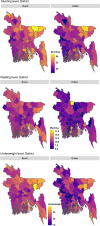Prevalence of child undernutrition measures and their spatio-demographic inequalities in Bangladesh: an application of multilevel Bayesian modelling
- PMID: 35585516
- PMCID: PMC9118603
- DOI: 10.1186/s12889-022-13170-4
Prevalence of child undernutrition measures and their spatio-demographic inequalities in Bangladesh: an application of multilevel Bayesian modelling
Abstract
Micro-level statistics on child undernutrition are highly prioritized by stakeholders for measuring and monitoring progress on the sustainable development goals. In this regard district-representative data were collected in the Bangladesh Multiple Indicator Cluster Survey 2019 for identifying localised disparities. However, district-level estimates of undernutrition indicators - stunting, wasting and underweight - remain largely unexplored. This study aims to estimate district-level prevalence of these indicators as well as to explore their disparities at sub-national (division) and district level spatio-demographic domains cross-classified by children sex, age-groups, and place of residence. Bayesian multilevel models are developed at the sex-age-residence-district level, accounting for cross-sectional, spatial and spatio-demographic variations. The detailed domain-level predictions are aggregated to higher aggregation levels, which results in numerically consistent and reasonable estimates when compared to the design-based direct estimates. Spatio-demographic distributions of undernutrition indicators indicate south-western districts have lower vulnerability to undernutrition than north-eastern districts, and indicate significant inequalities within and between administrative hierarchies, attributable to child age and place of residence. These disparities in undernutrition at both aggregated and disaggregated spatio-demographic domains can aid policymakers in the social inclusion of the most vulnerable to meet the sustainable development goals by 2030.
Keywords: Rural-urban disparities; Small area estimation; Spatial and cross-sectional correlations; Stunting; Underweight; Wasting.
© 2022. The Author(s).
Conflict of interest statement
The authors declare that they have no competing interests.
Figures












References
-
- WHO. Fact Sheet: Children – improving survival and wellbeing. 2020. https://www.who.int/news-room/fact-sheets/detail/children-reducing-morta.... Accessed 25 Aug 2021.
Publication types
MeSH terms
LinkOut - more resources
Full Text Sources
Medical

